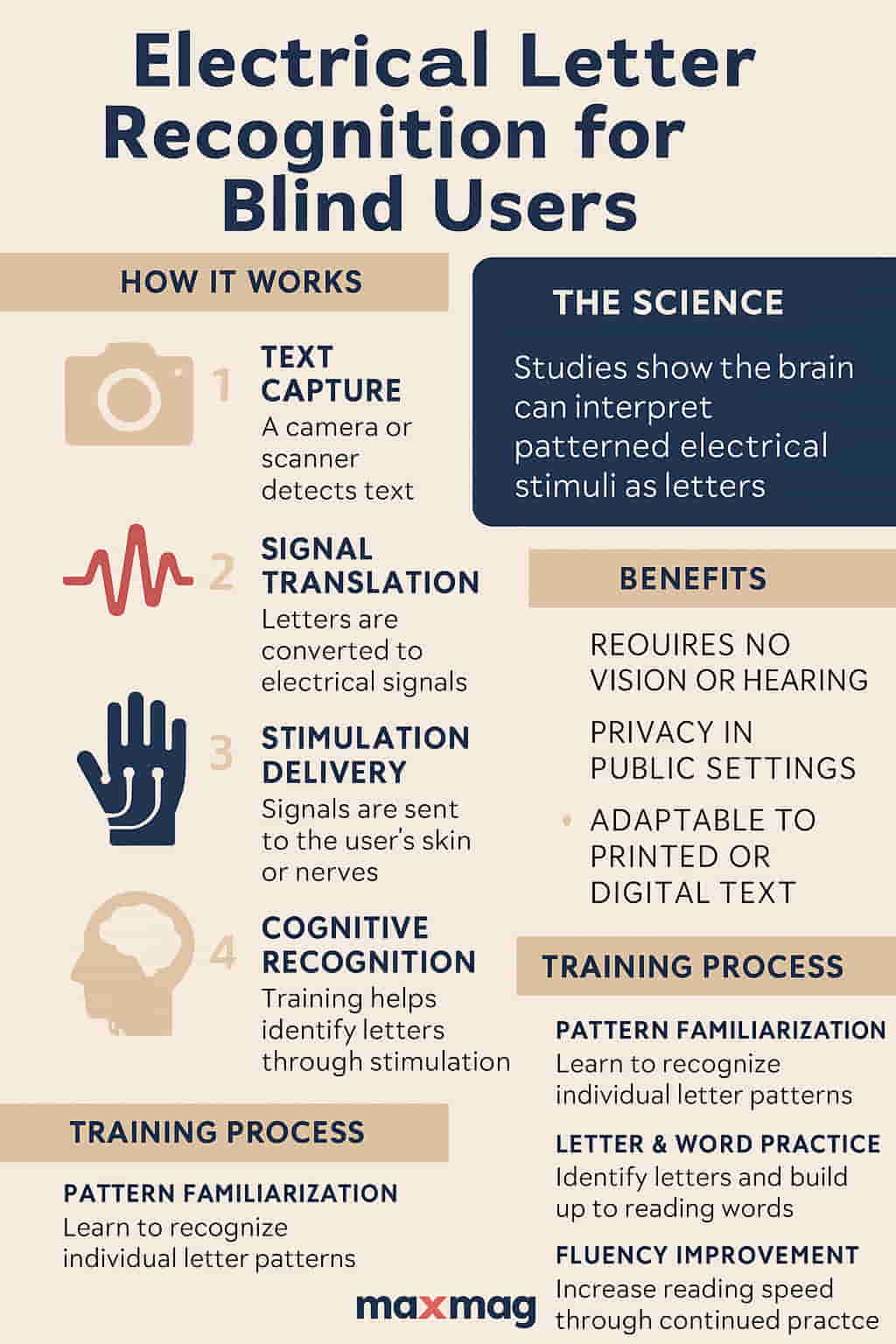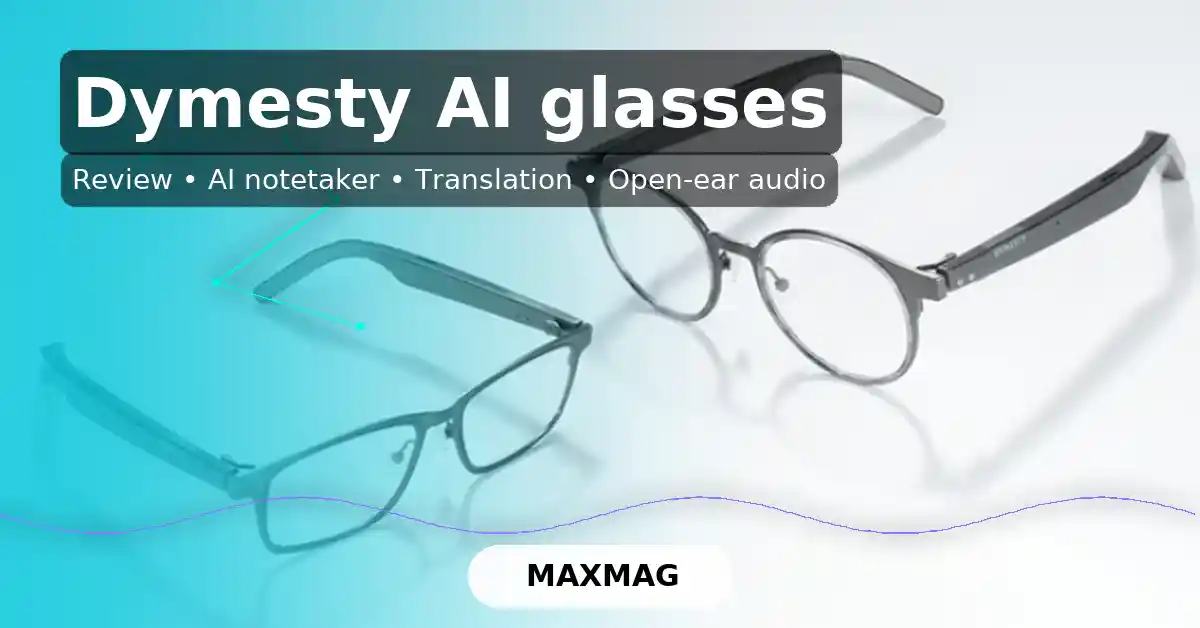
For centuries, people with blindness have relied on tools like Braille, screen readers, and audio books to access written content. While these tools have played a transformative role, they also have limitations—cost, bulk, learning curve, and lack of privacy in public spaces. But now, a new innovation is emerging that could dramatically expand how blind people interact with text: electrical letter recognition for blind users.
Imagine reading not through your eyes or ears, but through your skin—or even your brain. This technology, which uses gentle electrical pulses to represent letters, could redefine literacy and accessibility for millions. Here’s how it works, what it promises, and why it might be the biggest advancement in assistive tech in decades.
How It Works: Turning Electricity Into Language
At its core, electrical letter recognition for blind users involves converting letters or entire words into unique electrical stimulation patterns. These signals are then delivered to the body—typically to the skin or nerves—where they are interpreted by the brain as specific letters.
The process includes several key steps:
-
Text Capture – A small camera or scanner identifies printed or digital letters.
-
Signal Translation – Letters are converted into distinct electrical pulses, each with its own duration, intensity, and frequency.
-
Stimulation Delivery – These signals are sent through electrodes placed on the skin or, in some advanced models, via neural interfaces that target specific nerves.
-
Cognitive Recognition – After training, users learn to recognize these electrical “signatures” as actual letters or words.
Unlike Braille, which requires physical contact with raised dots, this system allows users to read printed material directly, without requiring text to be embossed or specially formatted.
The Science Behind It
This innovation draws on neuroscience, bioengineering, and machine learning. It’s based on the idea that the brain can learn to associate new sensations with language—just as sighted people learn to associate shapes with sounds and meanings.
Studies from institutions like Stanford University’s Bio-X Program have shown that the human brain is highly adaptable when exposed to consistent, patterned electrical input. Over time, the brain forms neural pathways to interpret these signals as familiar symbols.
In experiments, users began recognizing individual letters after only a few hours of training. With consistent use, people were able to read short words at a functional speed. While full fluency is still under development, early results are incredibly promising.
Electrical Letter Recognition for Blind Users – A Practical Solution
Today’s assistive technologies, while valuable, still have notable drawbacks. Audio-based systems don’t work well in noisy or quiet public settings. Braille is expensive to produce and requires specialized materials. And screen readers can be slow and clunky, especially when navigating complex visual content.
Electrical letter recognition for blind users offers an elegant solution to these problems. It is silent, portable, and adaptable to any language or font style.
For example, consider someone at a restaurant. With this technology, they could scan the printed menu and receive silent, real-time electrical pulses to read the text—without needing a waiter to read it aloud or relying on Braille menus (which are rare). This offers autonomy, privacy, and speed.
Research presented at the National Institutes of Health (NIH) highlights how non-invasive neural stimulation could one day allow even faster communication between devices and the human nervous system—making this concept more scalable.
Why This Is a Game-Changer for Education
One of the most exciting applications of this technology is in schools. Reading is the foundation of education, and students with visual impairments often face additional barriers in traditional classrooms.
Here’s how electrical letter recognition for blind users could revolutionize education:
-
Access to More Materials: Standard printed books, tests, and worksheets can become accessible immediately.
-
Lower Costs: Schools would no longer need to produce special Braille versions.
-
Inclusive Learning: Students can participate in class without delay or dependence on specialized staff.
Programs like those at the American Foundation for the Blind (AFB) are exploring how emerging tech can promote equal access in schools—and this method could become a centerpiece of their efforts.
Training the Brain to Read Electrically
A key part of this technology is the learning process. Much like how children learn to associate letters with sounds, users of electrical recognition systems must associate electrical patterns with letters.
Typically, the training involves:
-
Pattern Familiarization: Users feel a series of simple pulses that correspond to individual letters.
-
Letter Recognition Drills: They practice identifying these patterns without visual cues.
-
Word Construction: Once they’re comfortable with the alphabet, they move on to short words and eventually full sentences.
-
Fluency Exercises: Over time, reading speed increases as the brain becomes more efficient at decoding the patterns.
This kind of neuroplasticity—the brain’s ability to adapt to new inputs—is a powerful advantage, especially in younger users or those already experienced in Braille or audio-based systems.
Limitations and Future Directions
Despite its promise, electrical letter recognition for blind users still faces a few hurdles:
-
Customization Needs: Not everyone perceives electrical signals the same way, requiring personalized calibration.
-
Speed Limitations: Reading speed is currently slower than with audio or Braille, though it improves with practice.
-
Hardware Challenges: Devices must be comfortable, portable, and affordable.
However, researchers at the Georgia Institute of Technology are working on ultra-thin, flexible electrode arrays that can be embedded in wearable materials like gloves or armbands—pointing toward a future of truly seamless integration.
Outbound Resources for Further Reading
If you’re curious to explore the broader field of accessibility tech and neuroscience innovation, here are some excellent US-based resources:
-
Stanford Bio-X Program – Pioneering research into brain-computer interfaces.
-
National Institutes of Health – Covers current clinical trials in non-invasive neurostimulation.
-
American Foundation for the Blind – Offers news, advocacy, and updates on assistive technologies in education.
-
Georgia Tech Human-Centered Computing – Focused on wearable and adaptive technology for people with disabilities.
Who Can Benefit Most?
The potential beneficiaries of this technology are vast:
-
Children with congenital blindness – Faster literacy development
-
Adults with degenerative vision loss – Preserving reading ability
-
Professionals – Reading sensitive material in public without audio output
-
Multi-language learners – Devices can adapt to any language, increasing global reach
The universality and adaptability of this method make it truly revolutionary.
FAQ
Q1: Is this technology available commercially?
Not yet. It’s currently in experimental stages but is moving quickly toward pilot programs and potential mass production.
Q2: Does it require surgery?
No. Most systems rely on non-invasive electrical stimulation through wearable devices like wristbands or fingertip pads.
Q3: How long does training usually take?
Early recognition of letters can occur within a few days. Full fluency may take weeks of regular practice.
Q4: Is this better than Braille?
It’s not a replacement, but a powerful complement. It offers real-time access to standard printed materials without needing specialized formats.
Q5: Could it be combined with other technologies?
Yes. It can be integrated with OCR software, wearable cameras, or AI-driven translation systems for enhanced accessibility.
Conclusion: Reading, Redefined
In a world increasingly shaped by technological innovation, the ability to read without eyes or ears is no longer science fiction. Electrical letter recognition for blind users represents a radical step forward in human-computer interaction and inclusive design.
By delivering electrical impulses directly to the body or brain, this technology offers a silent, intuitive, and universal method of reading. While still evolving, it holds immense promise for education, employment, and daily life.
This is not just a breakthrough for the visually impaired—it’s a transformation in how we think about communication itself.





